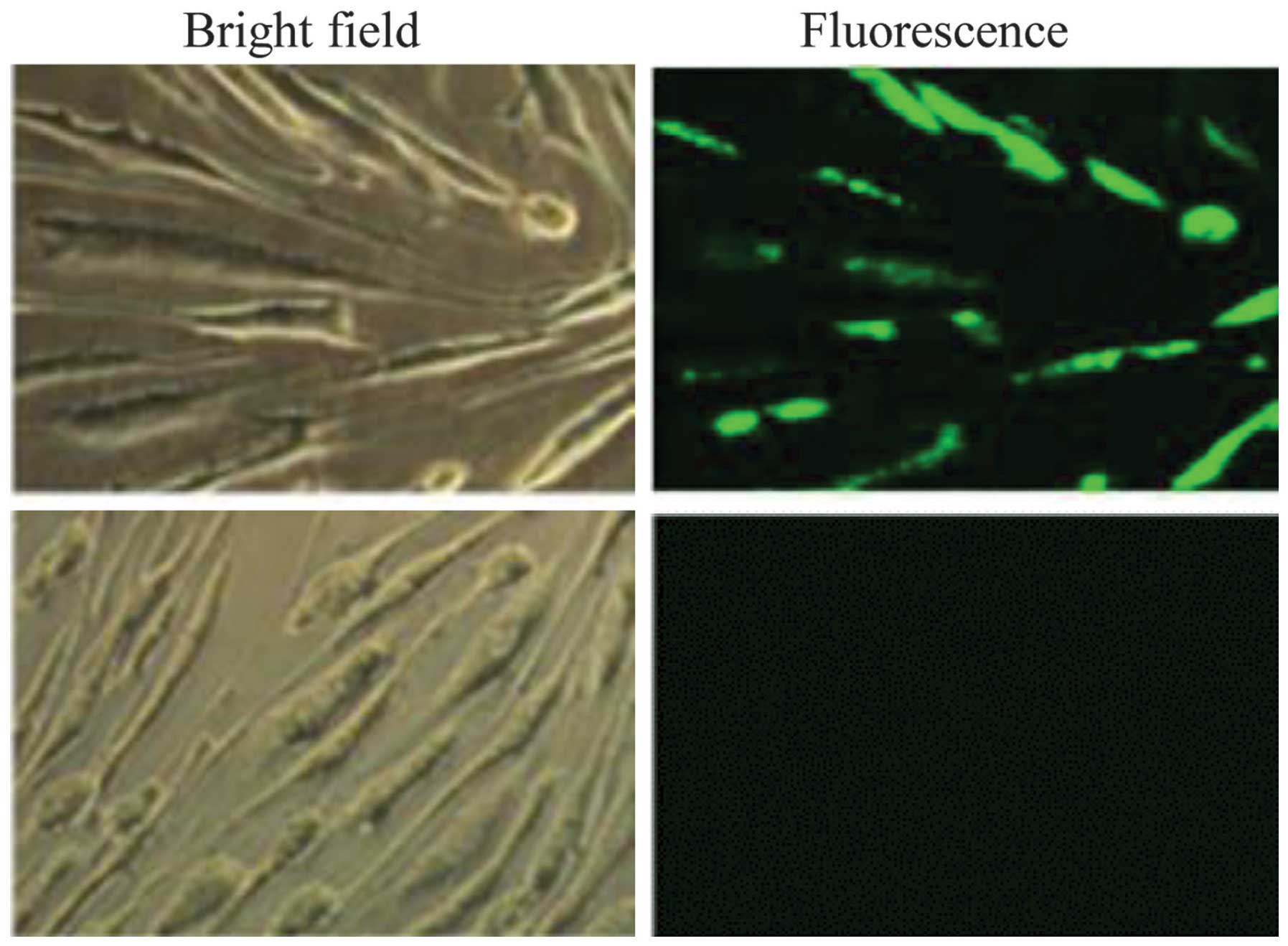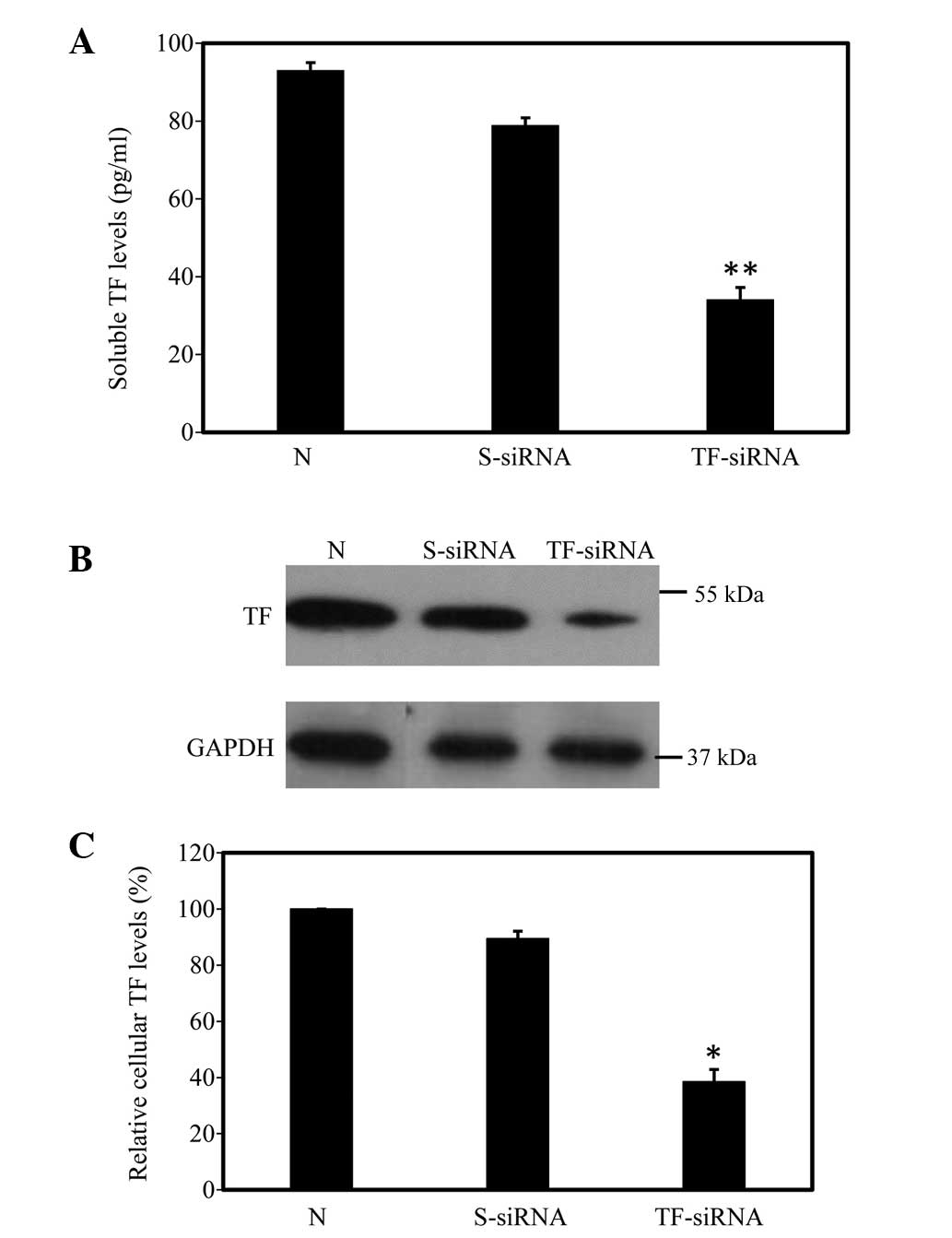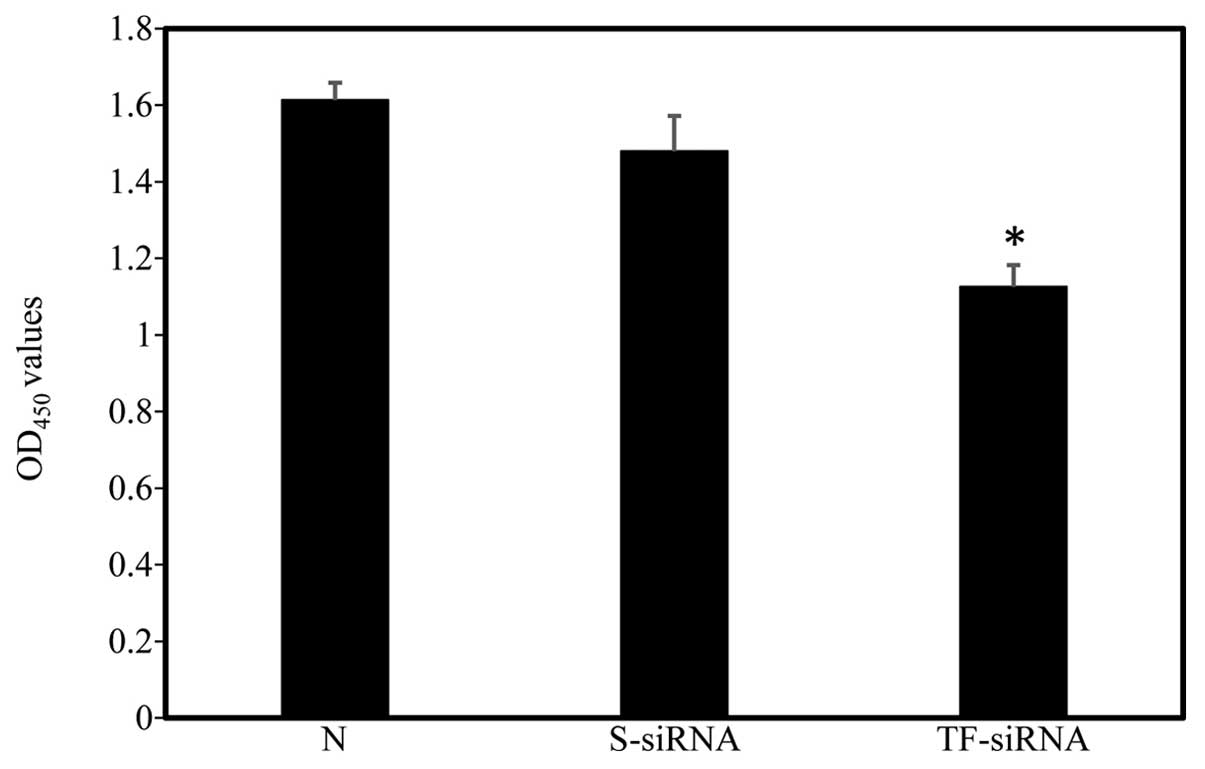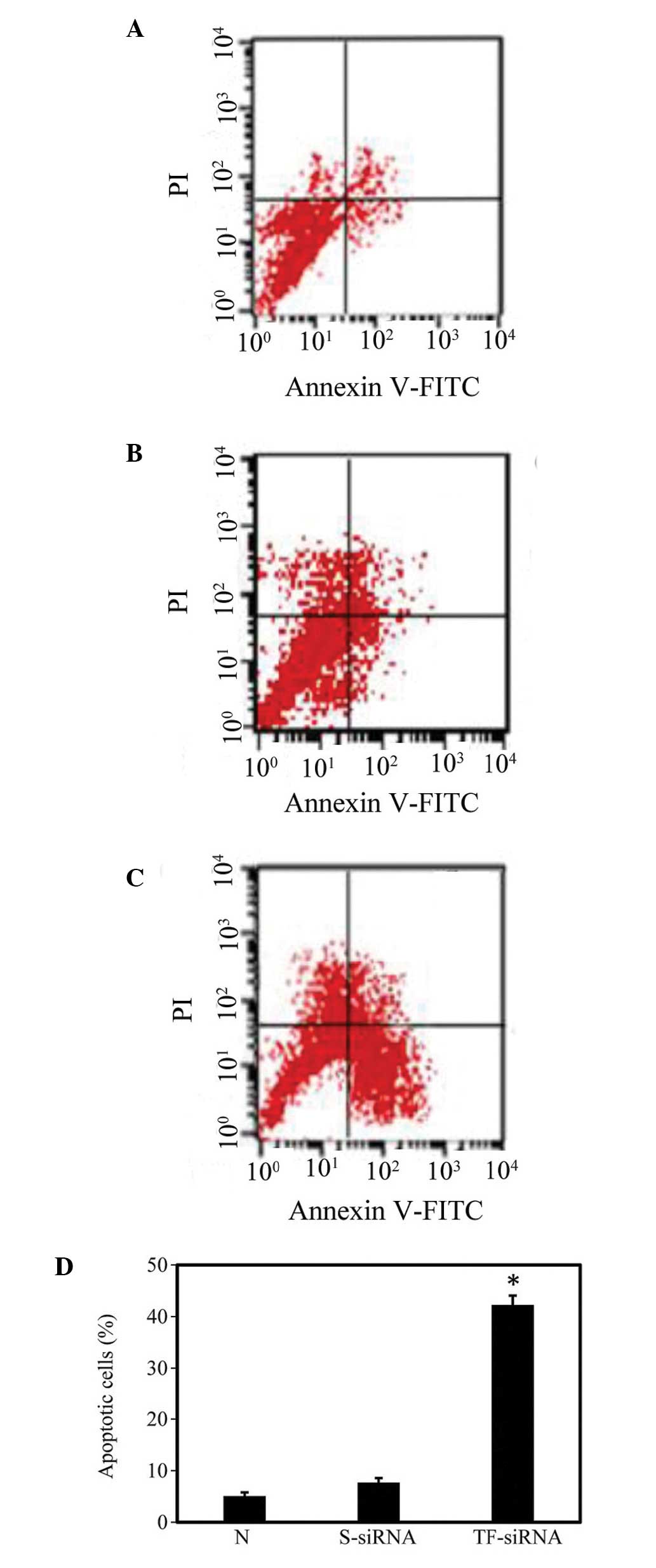Novel hydroxybutyl chitosan nanoparticles for siRNA delivery targeting tissue factor inhibits proliferation and induces apoptosis in human vascular smooth muscle cells
- Authors:
- Published online on: October 21, 2015 https://doi.org/10.3892/mmr.2015.4461
- Pages: 7957-7962
-
Copyright: © Wan et al. This is an open access article distributed under the terms of Creative Commons Attribution License.
Abstract
Introduction
Chitosan, a linear polysaccharide isolated from shrimp and other crustacean shells, possesses low toxicicity, is biodegradable and exhibits favorable biocompatible properties, rendering it a promising material for biomedical applications (1–3). Notably, several studies have investigated the potential of chitosan for drug delivery, bio-coating and the transferring of genetic materials (1–6). However, one setback, which limits the use of chitosan, is its insolubility under neutral conditions (3). Previously, a modified chitosan, namely hydroxybutyl chitosan (HBC), has been developed and exhibits advantages over the parental chitosan. HBC is prepared by the conjugation of hydroxybutyl groups to the hydroxyl and amino reactive sites of chitosan (7). This change confers the polymer solubility under neutral conditions, whilst maintaining low toxicity and retaining its biodegradable and appreciable biocompatible properties (7–9).
Tissue factor (TF) is an essential cofactor in the initiation of coagulation (10). It is constitutively expressed and can be upregulated by various stimuli, including platelet-derived growth factor (PDGF) in vascular smooth muscle cells (11,12). In response to cytokines and growth factors, endothelial cells, monocytes and macrophages also produce TF (13–19). Two forms of TF, membrane-bound and soluble TF, have been identified (10,12,20–22). TF has been implicated in the pathogenesis of cardiovascular diseases, including hypertension, atherosclerosis, acute coronary syndrome and restenosis following percutaneous coronary intervention, by promoting thrombus formation and inducing the migration and proliferation of vascular smooth muscle cells (23–29). Therefore, targeting TF has been suggested as an attractive strategy for the treatment of cardiovascular diseases (30). In the present study, the use of HBC for the transfer of siRNAs into primary human umbilical vein vascular smooth muscle cells (HUVSMCs) targeting TF was investigated, and the efficiency of HBC-mediated siRNA transfer was examined, as were the effects of TF knockdown on HUVSMC proliferation and apoptosis.
Materials and methods
siRNAs
All siRNAs were purchased from Invitrogen (Thermo Fisher Scientific, Inc., Waltham, MA, USA). A fluorescent FAM-labeled siRNA was used to examine transfer efficiency. An siRNA targeting human TF was designed, according to the published human TF cDNA sequence (gene accession number: M16553.1; GenBank; http://www.ncbi.nlm.nih.gov/nuccore/M16553.1). The sequence of the antisense strand was 5′-AUU UGU AGU GCC UGA AGC GCTT-3′. A scrambled RNA sequence was used as control.
Preparation of HBC/siRNA nanoparticles
HBC/siRNA nanoparticles were prepared as follows: The HBC solution (1 mg/ml) was made by dissolving HBC (molecular weight: 130–160 kDa; degree of deacetylation: 86%) provided by the Ocean University of China (Qingdao, China) in 0.2 M acetic acid (pH 5.5; Sigma-Aldrich, St. Louis, MO, USA). The siRNA (final concentration, 20 µmol/l) was mixed with tripolyphosphate (TPP) solution (0.5 mg/ml; Sigma-Aldrich) under magnetic stirring. HBC/siRNA nanoparticles were then produced by slowly adding 1 ml of the siRNA/TPP solution to 3 ml of the HBC solution with stirring for 30 min. The loading efficiency of the siRNA within HBC was determined as follows: The HBC/siRNA mixture, prepared as above, was centrifuged at 13,000 × g for 15 min, following which the supernatant was collected and the siRNA content in the supernatant was determined by measuring the absorbance at 260 nm using a spectrophotometer (UV-1100; Shimadzu Corporation, Kyoto, Japan). The loading efficiency was calculated as a percentage, as follows: Total siRNA used - free siRNA remaining in the supernatant) / total siRNA used.
Cell culture and siRNA transfer
Primary HUVSMCs (Bai Li Biological Technology, Shanghai, China) were maintained at 37°C in RPMI-1640 medium (Gibco, Thermo Fisher Scientific, Inc.) supplemented with 10% fetal bovine serum (FBS, Gibco; Thermo Fisher Scientific, Inc.), 100 U/ml penicillin and 0.1 mg/ml streptomycin (Gibco; Thermo Fisher Scientific, Inc.). Cells were used between passages four and nine. For siRNA transfer, the cells were detached with 0.25% trypsin (Thermo Fisher Scientific, Inc.), seeded on 24-well plates (1×105 cells/well) and incubated overnight at 37°C in complete RPMI-1640 medium. Following replacing of the medium with 250 µl Opti-MEM serum-free medium (Gibco; Thermo Fisher Scientific, Inc.), HBC/siRNA nanoparticle solution was added (siRNA final concentration, 200 nM). The cells were incubated at 37°C for 4 h to allow for siRNA uptake. Following incubation, the medium containing nanoparticles was replaced with fresh complete RPMI 1640 medium and the cells were maintained in culture and assayed at different time points (24, 48 and 72 h), as indicated. A total of 24 h post-transfection, five high-power fields were randomly selected under a fluorescence microscope (Nikon E600; Nikon Corporation, Tokyo, Japan), and total fluorescent cells in each field were counted. The percentage of average fluorescent cells over average total cells from the five fields was used to determine the transfection efficiency
TF protein measurement
As HUVSMCs express minimal basal TF, the cells examined in the present study were treated with PDGF-BB to enhance the production of TF protein. PDGF-BB (10 ng/ml, Sigma-Aldrich) was added to the cell culture 24 h following HBC/siRNA transfection. Inhibition of the PDGF-BB-induced expression of TF by TF-siRNA was then determined 48 h following siRNA transfection. The levels of soluble and cellular TF protein were measured using an enzyme-linked immunosorbent assay (ELISA) and western blotting, respectively. For the soluble TF assay, the cultured conditioned medium was collected, centrifuged at 10,000 × g for 10 min and the level of soluble TF in the medium was measured using a Human F3/Tissue Factor ELISA kit (cat. no. RAB0642-1KT; Sigma-Aldrich), according to the manufacturer's protocol. For western blotting, total protein was extracted using radio-immunoprecipitation assay lysis buffer (Sigma-Aldrich) and protein concentration was determined using a bicinchoninic acid assay (Pierce Biotechnology, Inc., Rockford, IL, USA), according to the manufacturer's protocol. The proteins (50 µg) were separated by 10% SDS-PAGE (Thermo Fisher Scientific, Inc.) and electrically transferred onto nitrocellulose membrane (Thermo Fisher Scientific, Inc.). The membrane was blocked with phosphate-buffered saline (pH 7.5) with 0.1% Tween-20 (PBST; Sigma-Aldrich) and 10% non-fat milk for 1 h at room temperature, and incubated overnight at 4°C with mouse anti-human TF monoclonal antibody (1:1,000; cat. no. ab17375; Abcam, Cambridge, MA, USA), followed by three washes with PBST. The membrane was then incubated with a horseradish peroxidase (HRP)-conjugated goat anti-mouse secondary antibody (1:5,000; cat. no. ab6789; Abcam) at room temperature for 1 h. Following three washes with PBST, the specific TF band was visualized using an ECL detection kit (Abcam). Glyceraldehyde 3-phosphate dehydrogenase (GAPDH) on the same membrane was probed with a mouse anti-human GAPDH monoclonal antibody (1:5,000; cat. no. ab9484; Abcam) as done with TF. Densitometric analysis was performed, and relative quantitation of TF normalized to GAPDH was determined using Image J software (National Institutes of Health, Bethesda, MA, USA).
Cell proliferation assay
HUVSMC proliferation was assessed 48 h following the addition of the HBC/siRNA nanoparticles using a Cell Counting Kit-8 (CCK-8; Sigma-Aldrich), according to the manufacturer's protocol. Briefly, the culture medium was replaced with fresh complete RPMI 1640 medium (without phenol red) containing 10% CCK-8 reagent. Following culture for 24 h, 200 µl of supernatant from each well was transferred to a 96-well plate for the measurement of optical density (OD) at 450 nm (OD450) using a microplate reader (model 550; Bio-Rad Laboratories, Inc., Hercules, CA, USA).
Cell apoptosis assay
Apoptosis of the HUVSMCs was assayed using an Annexin V-fluorescein isothiocyanate (FITC) Apoptosis Detection kit (Solarbio Science & Technology Co., Ltd., Beijing, China), according to the manufacturer's protocol. Briefly, 72 h after siRNA transfection, the cells were detached and resuspended in binding buffer (Solarbio Science & Technology Co., Ltd.) at a density of 1×106/ml. Subsequently, 100 µl of the cell suspension was incubated with 5 µl Annexin V-FITC and 10 µl propidium iodide at 4°C for 15 min in the dark. Following a single wash with PBS, the Annexin V-FITC-positive cells (apoptotic cells) were analyzed using a FACSCalibur Flow Cytometer (BD Biosciences, Franklin Lakes, NJ, USA).
Statistical analysis
Data are expressed as the mean ± standard deviation. Statistical analyses of the differences were performed using one way analysis of variance. Comparisons between two groups were performed using the least-significant difference test. SPSS 17.0 (SPSS, Inc., Chicago, IL, USA) and PRISM software (GraphPad Software, Inc., La Jolla, CA, USA) were used for statistical analyses and plotting. P<0.05 was considered to indicate a statistically significant difference.
Results
Preparation of HBC siRNA nanoparticles and siRNA transfer
HBC and siRNA solutions were mixed and stirred to form HBC/siRNA nanoparticles. TPP was used as a cross-linker to further stabilize the nanoparticle. This method resulted in an siRNA loading efficiency of 93.4±0.7% within HBC. Treatment of the HUVSMCs with nanoparticles, which were formed by mixing HBC and FAM-labeled siRNAs, showed green fluorescence in the transfected cells, as observed under fluorescence microscopy (Fig. 1). Counting of the numbers of fluorescent and total cells revealed a 74±2.5% transfection efficiency.
Knockdown of TF by HBC/TF-siRNA nanoparticles in HUVSMCs
Inhibition of the PDGF-BB-induced expression of TF by TF-siRNA in the HUVSMCs was determined 48 h following siRNA transfection. The ELISA results showed that the level of soluble TF in the TF-siRNA-transfected cells was 34.2±1.8 pg/ml, which was significantly lower than the level in the non-transfected cells (93.1±2.0 pg/ml; n=12; P<0.01). In the cells transfected with scrambled siRNA, the level of soluble TF was 79.0±3.0 pg/ml, which was not significantly different from that of the untreated cells (Fig. 2A). Western blotting revealed that the relative cellular level of TF in the TF-siRNA-transfected cells was 38.5±2.6% of that in the non-transfected cells (n=12; P<0.05). By contrast, scrambled siRNA transfection caused no significant reduction in the level of cellular TF (Fig. 2B and C).
TF knockdown inhibits HUVSMC proliferation
HUVSMC proliferation was measured 48 h following siRNA transfection using a CCK-8 kit. No significant differences were observed between the OD450 values of the non-transfected and scrambled siRNA-treated HUVSMCs. By contrast, TF-siRNA transfection significantly inhibited HUVMSC proliferation (Fig. 3; n=4).
TF knockdown increases HUVSMC apoptosis
HUVMSC apoptosis was assayed using Annexin V staining and flow cytometric analysis 72 h following siRNA delivery. As shown in Fig. 4, cell apoptotic rates were 5.1±0.71 and 7.73±0.87% in the non-transfected and HBC/scrambled siRNA nanoparticle-transfected cells, respectively. Statistical analysis demonstrated no significant difference between the levels of apoptosis in these two groups. However, the apoptotic rate in the TF-knockdown HUVMSCs was 42.25±1.82%, which was significantly higher than those observed in the non-transfected and scrambled siRNA-transfected cells (P<0.05; n=4).
Discussion
Despite significant efforts that have been made to improve chitosan as a non-viral gene delivery vector, the application is significantly limited by its poor solubility under physiological conditions (31). HBC, a soluble derivative of chitosan under neutral conditions, has been investigated as a scaffold for tissue engineering (32,33), however its use as a gene delivery carrier remains to be fully elucidated. In the present study, HBC was investigated as a vehicle for siRNA delivery targeting TF in HUVSMCs. HBC/siRNA nanoparticles were produced by mixing HBC and siRNA solutions with TPP as a cross-linker. This resulted in >90% of the siRNAs being loaded within HBC. Furthermore, treatment of the HUVSMCs with the HBC/fluorescence-siRNA nanoparticles resulted in a transfection efficiency of ~74%. These results validated that HBC was a promising vehicle for siRNA delivery.
siRNA binds an mRNA sequence through complementarity, which leads to the cleavage of target mRNA and, eventually, the inhibition of gene expression (34). siRNA has been investigated extensively for its therapeutic potential, for example in the use of siRNAs to silence tumor genes, or genes in which overexpression has been associated with disease (35,36). TF is involved in thrombus formation and stimulates the migration and proliferation of vascular smooth muscle cells, contributing to the pathogenesis of cardiovascular diseases (23–29). As a consequence, inhibition of the action of TF has been suggested as an attractive therapeutic approach for cardiovascular diseases (30). Following confirmation of effective siRNA delivery with HBC, the present study assessed whether HBC/TF-siRNA nanoparticles were able to inhibit the expression of TF in HUVSMCs, and examined the effect of TF knockdown on cell proliferation and apoptosis. The results showed that HBC-mediated TF-siRNA transfer suppressed the production of cellular and soluble TF, which led to the significant inhibition of cell proliferation and increase of cell apoptosis.
In conclusion, the present study demonstrated that HBC can be successfully applied for siRNA loading. HBC/siRNA nanoparticles mediated high siRNA transfection efficiency in HUVMSCs, and treatment of HUVSMCs with HBC/TF-siRNA nanoparticles inhibited the protein expression of TF, which led to decreased cell proliferation and enhanced cell apoptosis. These findings suggested that HBC may be a promising vector for siRNA delivery, and that in vivo HBC/siRNA nanoparticle delivery targeting TF is a potential therapeutic option for the treatment of cardiovascular diseases, warranting further investigation.
Acknowledgments
This study was supported by the National Natural Science Foundation of China (grant. no. 81200202); the Shandong Province Natural Science Foundation, China (grant. no. ZR2010HM081) and the China Postdoctoral Science Foundation (grant. no. 2012M511462).
References
|
Illum L: Chitosan and its use as a pharmaceutical excipient. Pharm Res. 15:1326–1331. 1998. View Article : Google Scholar : PubMed/NCBI | |
|
Felt O, Buri P and Gurny R: Chitosan: A unique polysaccharide for drug delivery. Drug Dev Ind Pharm. 24:979–993. 1998. View Article : Google Scholar | |
|
Kumar MN, Muzzarelli RA, Muzzarelli C, Sashiwa H and Domb AJ: Chitosan chemistry and pharmaceutical perspectives. Chem Rev. 104:6017–6084. 2004. View Article : Google Scholar : PubMed/NCBI | |
|
Nafee N, Taetz S, Schneider M, Schaefer UF and Lehr CM: Chitosan-coated PLGA nanoparticles for DNA/RNA delivery: Effect of the formulation parameters on complexation and transfection of antisense oligonucleotides. Nanomedicine. 3:173–183. 2007. View Article : Google Scholar : PubMed/NCBI | |
|
Köping-Höggård M, Tubulekas I, Guan H, Edwards K, Nilsson M, Vårum KM and Artursson P: Chitosan as a nonviral gene delivery system. Structure-property relationships and characteristics compared with polyethylenimine in vitro and after lung administration in vivo. Gene Ther. 8:1108–1121. 2001. View Article : Google Scholar : PubMed/NCBI | |
|
Katas H and Alpar HO: Development and characterisation of chitosan nanoparticles for siRNA delivery. J Control Release. 115:216–225. 2006. View Article : Google Scholar : PubMed/NCBI | |
|
Dang JM, Sun DD, Shin-Ya Y, Sieber AN, Kostuik JP and Leong KW: Temperature-responsive hydroxybutyl chitosan for the culture of mesenchymal stem cells and intervertebral disk cells. Biomaterials. 27:406–418. 2006. View Article : Google Scholar | |
|
Molinaro G, Leroux JC, Damas J and Adam A: Biocompatibility of thermosensitive chitosan-based hydrogels: An in vivo experimental approach to injectable biomaterials. Biomaterials. 23:2717–2722. 2002. View Article : Google Scholar : PubMed/NCBI | |
|
Wei CZ, Hou CL, Gu QS, Jiang LX, Zhu B and Sheng AL: A thermosensitive chitosan-based hydrogel barrier for post-operative adhesions' prevention. Biomaterials. 30:5534–5540. 2009. View Article : Google Scholar : PubMed/NCBI | |
|
Mackman N, Morrissey JH, Fowler B and Edgington TS: Complete sequence of the human tissue factor gene, a highly regulated cellular receptor that initiates the coagulation protease cascade. Biochemistry. 28:1755–1762. 1989. View Article : Google Scholar : PubMed/NCBI | |
|
Wilcox JN, Smith KM, Schwartz SM and Gordon D: Localization of tissue factor in the normal vessel wall and in the atherosclerotic plaque. Proc Natl Acad Sci USA. 86:2839–2843. 1989. View Article : Google Scholar : PubMed/NCBI | |
|
Schecter AD, Giesen PL, Taby O, Rosenfield CL, Rossikhina M, Fyfe BS, Kohtz DS, Fallon JT, Nemerson Y and Taubman MB: Tissue factor expression in human arterial smooth muscle cells. TF is present in three cellular pools after growth factor stimulation. J Clin Invest. 100:2276–2285. 1997. View Article : Google Scholar : PubMed/NCBI | |
|
Camera M, Giesen PL, Fallon J, Aufiero BM, Taubman M, Tremoli E and Nemerson Y: Cooperation between VEGF and TNF-alpha is necessary for exposure of active tissue factor on the surface of human endothelial cells. Arterioscler Thromb Vasc Biol. 19:531–537. 1999. View Article : Google Scholar : PubMed/NCBI | |
|
Bavendiek U, Libby P, Kilbride M, Reynolds R, Mackman N and Schönbeck U: Induction of tissue factor expression in human endothelial cells by CD40 ligand is mediated via activator protein 1, nuclear factor kappa B and Egr-1. J Biol Chem. 277:25032–25039. 2002. View Article : Google Scholar : PubMed/NCBI | |
|
Kawano H, Tsuji H, Nishimura H, Kimura S, Yano S, Ukimura N, Kunieda Y, Yoshizumi M, Sugano T, Nakagawa K, et al: Serotonin induces the expression of tissue factor and plasminogen activator inhibitor-1 in cultured rat aortic endothelial cells. Blood. 97:1697–1702. 2001. View Article : Google Scholar : PubMed/NCBI | |
|
Cermak J, Key NS, Bach RR, Balla J, Jacob HS and Vercellotti GM: C-reactive protein induces human peripheral blood monocytes to synthesize tissue factor. Blood. 82:513–520. 1993.PubMed/NCBI | |
|
Mach F, Schönbeck U, Bonnefoy JY, Pober JS and Libby P: Activation of monocyte/macrophage functions related to acute atheroma complication by ligation of CD40: Induction of collagenase, stromelysin and tissue factor. Circulation. 96:396–399. 1997. View Article : Google Scholar : PubMed/NCBI | |
|
He M, He X, Xie Q, Chen F and He S: Angiotensin II induces the expression of tissue factor and its mechanism in human monocytes. Thromb Res. 117:579–590. 2006. View Article : Google Scholar | |
|
Wada H, Kaneko T, Wakita Y, Minamikawa K, Nagaya S, Tamaki S, Deguchi K and Shirakawa S: Effect of lipoproteins on tissue factor activity and PAI-II antigen in human monocytes and macrophages. Int J Cardiol. 47(Suppl 1): S21–S25. 1994. View Article : Google Scholar : PubMed/NCBI | |
|
Giesen PL, Rauch U, Bohrmann B, Kling D, Roqué M, Fallon JT, Badimon JJ, Himber J, Riederer MA and Nemerson Y: Blood-borne tissue factor: Another view of thrombosis. Proc Natl Acad Sci USA. 96:2311–2315. 1999. View Article : Google Scholar : PubMed/NCBI | |
|
Bogdanov VY, Balasubramanian V, Hathcock J, Vele O, Lieb M and Nemerson Y: Alternatively spliced human tissue factor: A circulating, soluble, thrombogenic protein. Nat Med. 9:458–462. 2003. View Article : Google Scholar : PubMed/NCBI | |
|
Szotowski B, Antoniak S, Poller W, Schultheiss HP and Rauch U: Procoagulant soluble tissue factor is released from endothelial cells in response to inflammatory cytokines. Circ Res. 96:1233–1239. 2005. View Article : Google Scholar : PubMed/NCBI | |
|
Day SM, Reeve JL, Pedersen B, Farris DM, Myers DD, Im M, Wakefield TW, Mackman N and Fay WP: Macrovascular thrombosis is driven by tissue factor derived primarily from the blood vessel wall. Blood. 105:192–198. 2005. View Article : Google Scholar | |
|
Soejima H, Ogawa H, Yasue H, Kaikita K, Takazoe K, Nishiyama K, Misumi K, Miyamoto S, Yoshimura M, Kugiyama K, et al: Angiotensin-converting enzyme inhibition reduces monocyte chemoattractant protein-1 and tissue factor levels in patients with myocardial infarction. J Am Coll Cardiol. 34:983–988. 1999. View Article : Google Scholar : PubMed/NCBI | |
|
Koh KK, Chung WJ, Ahn JY, Han SH, Kang WC, Seo YH, Ahn TH, Choi IS and Shin EK: Angiotensin II type 1 receptor blockers reduce tissue factor activity and plasminogen activator inhibitor type-1 antigen in hypertensive patients: A randomized, double-blind, placebo-controlled study. Atherosclerosis. 177:155–160. 2004. View Article : Google Scholar : PubMed/NCBI | |
|
Mälarstig A, Tenno T, Johnston N, Lagerqvist B, Axelsson T, Syvänen AC, Wallentin L and Siegbahn A: Genetic variations in the tissue factor gene are associated with clinical outcome in acute coronary syndrome and expression levels in human monocytes. Arterioscler Thromb Vasc Biol. 25:2667–2672. 2005. View Article : Google Scholar : PubMed/NCBI | |
|
Ott I, Koch W, von Beckerath N, de Waha R, Malawaniec A, Mehilli J, Schömig A and Kastrati A: Tissue factor promotor polymorphism-603 A/G is associated with myocardial infarction. Atherosclerosis. 177:189–191. 2004. View Article : Google Scholar : PubMed/NCBI | |
|
Pyo RT, Sato Y, Mackman N and Taubman MB: Mice deficient in tissue factor demonstrate attenuated intimal hyperplasia in response to vascular injury and decreased smooth muscle cell migration. Thromb Haemost. 92:451–458. 2004.PubMed/NCBI | |
|
Giannarelli C, Alique M, Rodriguez DT, Yang DK, Jeong D, Calcagno C, Hutter R, Millon A, Kovacic JC, Weber T, et al: Alternatively spliced tissue factor promotes plaque angiogenesis through the activation of hypoxia-inducible factor-1α and vascular endothelial growth factor signaling. Circulation. 130:1274–1286. 2014. View Article : Google Scholar : PubMed/NCBI | |
|
Steffel J, Lüscher TF and Tanner FC: Tissue factor in cardiovascular diseases: Molecular mechanisms and clinical implications. Circulation. 113:722–731. 2006. View Article : Google Scholar : PubMed/NCBI | |
|
Mao S, Sun W and Kissel T: Chitosan-based formulations for delivery of DNA and siRNA. Adv Drug Deliv Rev. 62:12–27. 2010. View Article : Google Scholar | |
|
Zhang K, Qian Y, Wang H, Fan L, Huang C, Yin A and Mo X: Genipin-crosslinked silk fibroin/hydroxybutyl chitosan nano-fibrous scaffolds for tissue-engineering application. J Biomed Mater Res A. 95:870–881. 2010. View Article : Google Scholar : PubMed/NCBI | |
|
Chen B, Dang J, Tan TL, Fang N, Chen WN, Leong KW and Chan V: Dynamics of smooth muscle cell deadhesion from thermosensitive hydroxybutyl chitosan. Biomaterials. 28:1503–1514. 2007. View Article : Google Scholar | |
|
Morris KV, Chan SW, Jacobsen SE and Looney DJ: Small interfering RNA-induced transcriptional gene silencing in human cells. Science. 305:1289–1292. 2004. View Article : Google Scholar : PubMed/NCBI | |
|
Ryther RC, Flynt AS, Phillips JA III and Patton JG: SiRNA therapeutics: Big potential from small RNAs. Gene Ther. 12:5–11. 2005. View Article : Google Scholar | |
|
Kanasty R, Dorkin JR, Vegas A and Anderson D: Delivery materials for siRNA therapeutics. Nat Mater. 12:967–977. 2013. View Article : Google Scholar : PubMed/NCBI |













